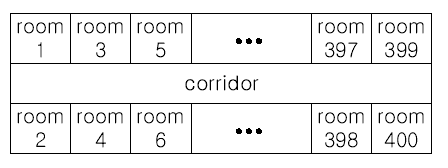HDU ACM 1050 Moving Tables
Problem Description

The floor has 200 rooms each on the north side and south side along the corridor. Recently the Company made a plan to reform its system. The reform includes moving a lot of tables between rooms. Because the corridor is narrow and all the tables are big, only one table can pass through the corridor. Some plan is needed to make the moving efficient. The manager figured out the following plan: Moving a table from a room to another room can be done within 10 minutes. When moving a table from room i to room j, the part of the corridor between the front of room i and the front of room j is used. So, during each 10 minutes, several moving between two rooms not sharing the same part of the corridor will be done simultaneously. To make it clear the manager illustrated the possible cases and impossible cases of simultaneous moving.

For each room, at most one table will be either moved in or moved out. Now, the manager seeks out a method to minimize the time to move all the tables. Your job is to write a program to solve the manager’s problem.
125 158
176 48
196 65
21 171
15 170
17 100
61 116
3 189
98 104
112 19
163 66
42 14
81 168
53 165
36 143
84 140
105 199
195 151
#include<cstdio>
#include<cstring>
#include<cmath>
#include<algorithm>
#define SIZE 404 using namespace std; typedef struct item{
int begin, end;
}item;
item room[SIZE];
bool visit[SIZE];
int n; bool cmp(const item& a, const item& b)
{
return a.begin < b.begin;
} void Traverse(int cnt, int sum)
{
if(sum == n)
{
printf("%d\n", cnt*);
return;
}
int temp = , count = ;
for(int i=; i<n; ++i)
{
if(!visit[i] && temp < room[i].begin)
{
count++;
temp = room[i].end;
visit[i] = true;
}
}
Traverse(cnt+, sum+count);
} int main()
{
#ifndef ONLINE_JUDGE
freopen("input.txt", "r", stdin);
#endif
int T, left, right;
scanf("%d", &T);
while(T--)
{
scanf("%d", &n);
for(int i=; i<n; ++i)
{
scanf("%d", &left);
room[i].begin = left = left + (left % );
scanf("%d", &right);
room[i].end = right = right + (right % );
if(left > right)
{
room[i].begin = right;
room[i].end = left;
}
}
memset(visit, false, sizeof(visit));
sort(room, room+n, cmp);
Traverse(, );
}
}
HDU ACM 1050 Moving Tables的更多相关文章
- POJ 1083 && HDU 1050 Moving Tables (贪心)
Moving Tables Time Limit: 2000/1000 MS (Java/Others) Memory Limit: 65536/32768 K (Java/Others) To ...
- HDOJ 1050 Moving Tables
Moving Tables Time Limit: 2000/1000 MS (Java/Others) Memory Limit: 65536/32768 K (Java/Others)Tot ...
- 1050 Moving Tables
Moving Tables Time Limit: 2000/1000 MS (Java/Others) Memory Limit: 65536/32768 K (Java/Others) To ...
- hdoj 1050 Moving Tables【贪心区间覆盖】
Moving Tables Time Limit: 2000/1000 MS (Java/Others) Memory Limit: 65536/32768 K (Java/Others)Tot ...
- hdu 1050 Moving Tables 解题报告
题目链接:http://acm.hdu.edu.cn/showproblem.php?pid=1050 这道题目隔了很久才做出来的.一开始把判断走廊有重叠的算法都想错了.以为重叠只要满足,下一次mov ...
- --hdu 1050 Moving Tables(贪心)
题目链接:http://acm.hdu.edu.cn/showproblem.php?pid=1050 AC code: #include<stdio.h> #include<str ...
- hdu 1050 Moving Tables
http://acm.hdu.edu.cn/showproblem.php?pid=1050 这个题我首先直接用的常规贪心,用的和那个尽可能看更多完整节目那种思路.但是.......一直WA....T ...
- HDU – 1050 Moving Tables
http://acm.hdu.edu.cn/showproblem.php?pid=1050 当时这道题被放在了贪心专题,我又刚刚做了今年暑假不AC所以一开始就在想这肯定是个变过型的复杂贪心,但是后来 ...
- hdu 1050 Moving Tables (Greedy)
Problem - 1050 过两天要给12的讲贪心,于是就做一下水贪心练习练习. 代码如下: #include <cstdio> #include <iostream> #i ...
随机推荐
- Android内存管理(1)WRANGLING DALVIK: MEMORY MANAGEMENT IN ANDROID PART 1
from : http://www.raizlabs.com/dev/2014/03/wrangling-dalvik-memory-management-in-android-part-1-of-2 ...
- 总结Selenium自动化测试方法(四)WebDriver常用的操作
四.WebDriver常用的操作 1.控制浏览器操作 #控制浏览器的大小 self.driver.set_window_size(480,800) #控制浏览器返回 self.driver.back( ...
- nginx.conf 配置文件详解
简单的实现nginx在前端做反向代理服务器的例子,处理js.png等静态文件,jsp等动态请求转发到其它服务器tomcat: user www www; worker_processes ; erro ...
- Android Studio AVD和SDK Manager灰色不能点击的问题。
之前安装完Android Studio之后,迫不及待的打开,新建项目,发现模板新建之后里面没有文件,并且AVD Manager和SDK Manager 那一排的按钮灰色不能点. 之后查阅资料无果,最后 ...
- Android在OnCreate中获取控件的宽度和高度
在Android中,有时需要对控件进行测量,得到的控件宽度和高度可以用来做一些计算.在需要自适应屏幕的情况下,这种计算就显得特别重要.另一方便,由于需求的原因,希望一进入界面后,就能得到控件的宽度和高 ...
- c#中获取服务器IP,客户端IP以及Request.ServerVariables详细说明
客户端ip: Request.ServerVariables.Get("Remote_Addr").ToString(); 客户端主机名: Request.ServerVaria ...
- HDU (线段树 单点更新) 敌兵布阵
哎,又切了一天的水题. 线段树果然必须自己写出来才能叫真正的会了,之前一直在套模板确实不好. 这个题目是单点更新 之 单点增减,= ̄ω ̄= #include <cstdio> <&l ...
- HDU 1422 重温世界杯
题目中说只需按照所给顺序,不论起点,输出能连续旅游的最多的城市 就是不论起点这句,我就卡住了.. 看了别人的题解,循环个2n-1次便是把所有的起点都考虑进去了. 更详细的解释在代码的注释里. //#d ...
- HTML xmlns
xmlns 属性可以在文档中定义一个或多个可供选择的命名空间.该属性可以放置在文档内任何元素的开始标签中.该属性的值类似于 URL,它定义了一个命名空间,浏览器会将此命名空间用于该属性所在元素内的所有 ...
- Cocoa & Cocoa Touch概念
Application Kit框架包括广泛的类和方法,它们用来开发交互式图形应用程序,使得开发文本/菜单/工具栏/表/文档/剪贴板和窗口之类的过程变得十分简便.在Mac OSX操作系统中,术语coco ...
